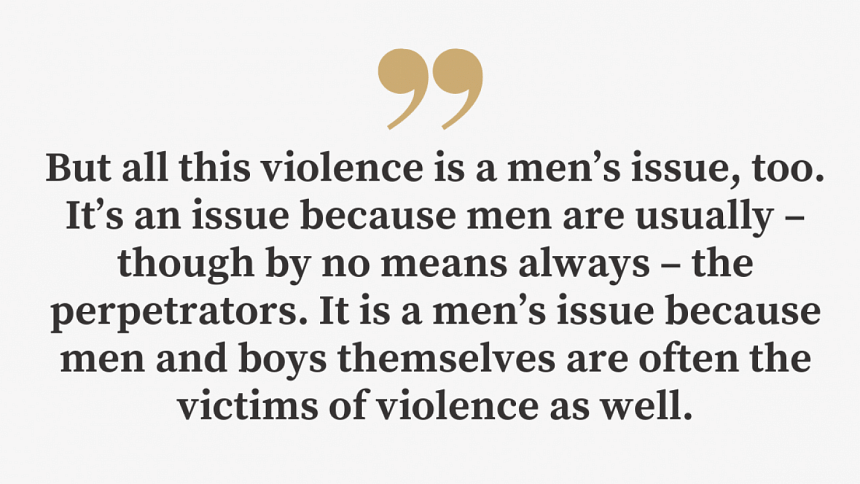Is violence against women only a women’s issue?

Acts of violence against women are regularly featured in the news. How to increase safety for women is a regular topic of discussion. Whether it is domestic violence or sexual assault, the focus is on the victim – or to use a better term, survivor.
American author and educator Jackson Katz points out in an excellent TED Talk that there is a problem with all of this. Missing from the picture, too often, is the man carrying out the acts of violence.
A moment's reflection reveals the oddity of the situation. We don't devote most of our attention to the victims of theft or murder while ignoring the thief or murderer. We don't talk about how to create cities where people are safe from theft or homicide. But somehow, when women are involved, the spotlight shifts to the one assaulted, while the one doing the assaulting magically vanishes from sight.
There are a couple of problems with this situation. For one, placing all of the attention on the victim leads to victim-blaming. What did she do to instigate the violence? What was she wearing when the rape occurred? The suggestion is that if only women changed their behaviour, the problem would disappear.
Another problem is that formulating violence as a women's issue allows men to absent themselves from the solution – if a man is not violent himself, it is not his problem. He has no need to speak up; his voice may not even be welcome. After all, it's a women's issue. When other men make crude remarks about women or trivialise violence, he stays silent or laughs.
But all this violence is a men's issue, too. It's an issue because men are usually – though by no means always – the perpetrators. It is a men's issue because men and boys themselves are often the victims of violence as well. It is a men's issue because men need to stand up and be vocal about their refusal to accept that violence is a normal part of masculinity. Just as there is a growing movement to say that it is not enough to not be racist – we need to be anti-racist – it is not enough simply not to engage in deplorable behaviour. We all need to speak up against it. And since men still possess more power in society, their voices remain more powerful, and thus more important.

There is another thing we all can do: challenge the language that focuses on women and leads to the exclusion of men. When we hear people refer to violence against women, we can remind them that we need to talk about violence carried out by men. When we hear people talking about making places safer for women, we can remind them that we need to talk about reducing male violence. We cannot afford to exclude men from this issue. Men are (normally) the ones carrying out the violence; they need to be a major part of the solution.
People in power also need to be held accountable for addressing violence in their institutions, be they religious, educational or other. Those in power must bear responsibility for what occurs under their watch.
In addition to encouraging men to take a strong stance against violence, we need to put forward positive images of masculinity. There is too much that is toxic in masculinity as typically defined: too much aggression, naked strength and violence.
Even the image of men as protectors suggests that women are weak objects requiring protection. We can instead promote images involving sharing and caring, women and men working together with mutual respect towards common goals. Men as well as women carrying out household work and raising children, making decisions together, working together as equals.
We have quite a long way to go, and I am unaware of any society that has eliminated violence, but some societies definitely do much better than others. It's time to learn from those that are doing better, and to ensure that men, as the ones with the most power, are held responsible for their actions as well as for their silence.
Debra Efroymson is the executive director of the Institute of Wellbeing and author of Beyond Apologies: Defining and Achieving an Economics of Wellbeing.

 For all latest news, follow The Daily Star's Google News channel.
For all latest news, follow The Daily Star's Google News channel. 







Comments